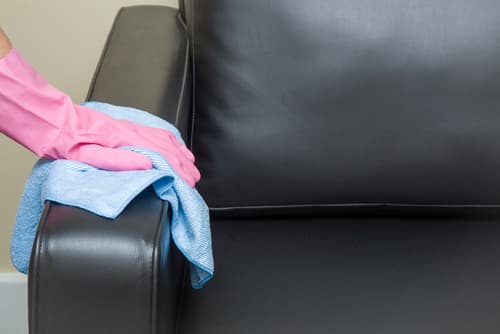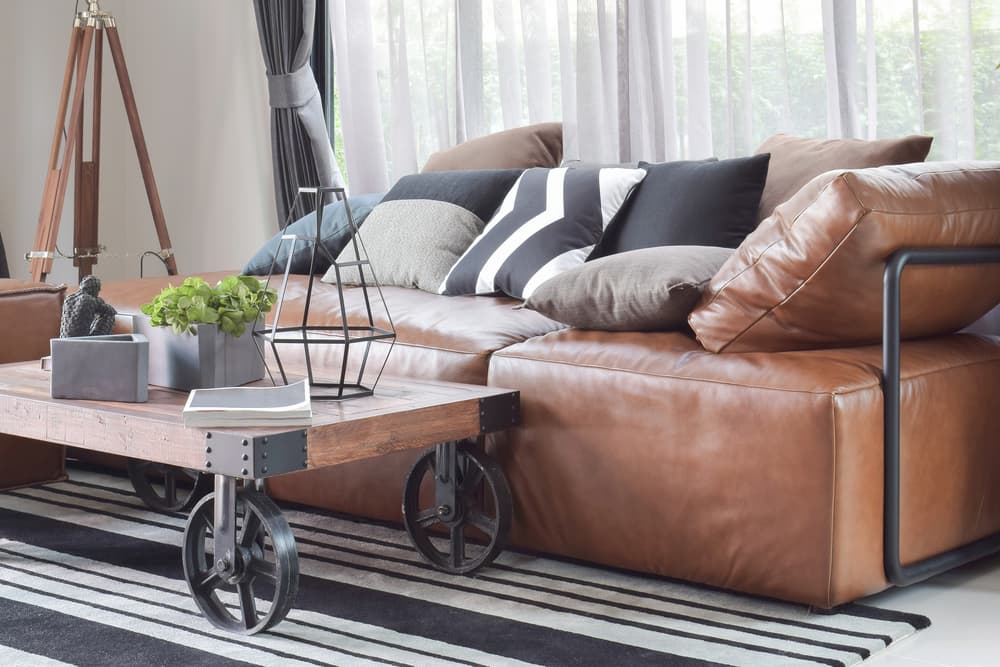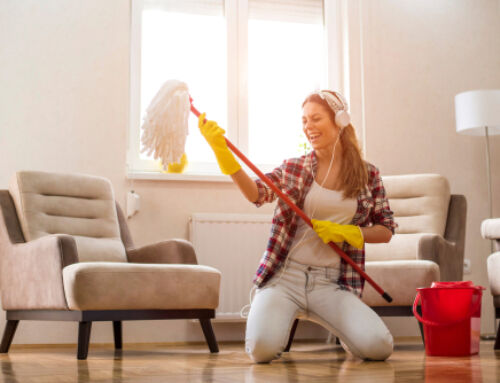Leather upholstery is beautiful and luxurious, but it does require careful maintenance to keep its shine. Many homeowners wonder how to make leather last and keep it in great shape. Spills and staining are a normal part of everyday life in every household, but you may be asking how to take care of leather furniture and remove these unsightly blotches. Read on to learn expert tips and look after your prized possessions like a true professional.
Leather is made from animal hides or skins, and different leathers result from different animals and treatment techniques. Cowhide is the most popular type of leather, comprising the majority of leather produced. Leather is produced by tanning and treating a raw animal hide. Tanned leather can remain supple and strong for a very long time, creating beautiful couches, chairs and car seats.
Types of Leather
Top Grain – The thickest and most durable type of leather, it includes the outside layer of the hide, referred to as the grain. There are three types of Top Grain leather:
- Full-grain – Considered the highest quality leather, it includes all of the grain, making it a very durable product.
- Corrected-grain – While this leather still includes the top grain, the grain has been chemically treated or sanded to create a more uniform appearance and eliminate surface flaws.
- Nubuck – Top grain leather that has been buffed or sanded on the grain, or outer side of the hide, to give it a smooth appearance and feel like that of suede.
Split Leather – This leather is made from what’s left, called the corium, after the top grain is removed from the hide. Although it feels smoother and softer without the top grain, it is not as durable. There are three types of split leather:
- Suede – Made from the underside of the animal skin, suede has a soft, smooth nap. Younger animals produce softer naps.
- Bi-cast – This split leather has a layer of vinyl added to it. While the vinyl layer gives the appearance of full-grain leather, it makes it stiffer and not as high quality.
- Patent leather – A lacquered finish is added to the split leather to give it a smooth, shiny appearance.
Bonded Leather – Leather scraps are fused together to create the appearance of a full sheet of leather.
Faux Leather – A material made from synthetic materials to look like leather. Made from a plastic base, it doesn’t have nearly the durability and porous nature of real leather. While this is a cruelty-free “leather,” there is some environmental impact from the production of man-made materials.
Types of Tanning
 Leather can be treated and tanned in several ways. The two most popular and common tanning methods are:
Leather can be treated and tanned in several ways. The two most popular and common tanning methods are:
- Vegetable-tanned leather – The most ancient way to tan leather, this method uses vegetable matter, like tree bark, to create a light brown or taupe color. This method takes time and produces a very supple leather.
- Chrome-tanned leather – This process is named for the chromium salts used to tan the leather. Because it is fast, it is a popular process and the final color is easier to control.
Do leather stains come out?
How do you get a stain out of a leather couch? Dealing with spills and stains on leather is tricky and has a lot to do with how the material is treated.
Here are some tips for cleaning leather:
- Know your leather. The type of leather you want to clean dictates what cleaning method you use. Finished or treated leather (like bi-cast leather) is covered in a protective coating, while suede and unfinished/untreated leather are not. A small amount of saddle soap is fine to use on a finished leather couch, but even mild soap can be too harsh for the most sensitive leathers. If you’re not sure how your leather will react to cleaning, test your cleaning agent in an inconspicuous area.
- Avoid DIY cleaning solutions. For leather, it’s better to use either water or cleaning products specifically designed for leather. Popular home remedies like baking soda, white vinegar, cream of tartar, and lemon juice are harsh on untreated leathers and make matters worse.
- Treat stains as soon as they happen. As is true of most stains, treating them right away by blotting with a soft cloth to remove as much of the moisture as possible is the best action to take. Then dab the area with a soft cloth dampened with warm water only – no soap. You can also use a cloth dampened with leather cleaner. If you’re using a leather cleaner in a spray bottle, spray the product on a cloth, not directly on the surface of the leather. Blot – don’t rub and don’t use a lot of pressure or you could cause a bigger stain. Blot again with a damp cloth.
- Moisturize. After cleaning the leather with water or leather cleaner, use a leather conditioner to restore moisture. Using a sponge, soft cloth, or microfiber cloth, gently rub the leather conditioner into the leather with a circular motion.
- Call a professional. Grease stains, sweat stains, ink stains, and make-up stains that don’t come out after a gentle spot cleaning may need to be professionally cleaned.
- Protect your leather. Regularly vacuum your leather furniture of grit and wipe away dirt and grime.
- Place your leather furniture carefully. Sun will bleach and cause deterioration of leather, and heat will make it crack and dry. Be careful when placing your leather furniture near large windows or heating grates.
Can you remove stains from suede?
Suede is a vulnerable leather, not only because of the dying process but because the nap is porous and quickly wicks up stains. Both regular use and liquid spills can flatten the nap of the suede. Blot spills quickly using the technique described above. Regularly use a slightly dampened cloth to brush and perk up the nap. Only a professional leather refinisher can fully restore a flattened or damaged nap.
How do you maintain leather?
Here’s what to do in terms of care:
- You can wipe leather with a soft cloth dampened with water to clean off an occasional spot, but don’t let the area get too wet or let the water soak in.
- Never let water stand on leather. If the water is absorbed by the leather it will cause a stain that is difficult to remove.
- Use saddle soap or other leather conditioners according to product directions.
- No matter what type of leather furniture you have, vacuuming should be an important part of its regular maintenance.
- Suede can be brushed with a slightly damp terry cloth towel to spiff up its nap.
- Beyond vacuuming, there’s not much you can do for dyed leather, and if it becomes stained or soiled, professional cleaning is your only recourse.
How do you clean a stained leather couch?
How do you clean a leather sofa at home? As with most spills, the faster you clean it up off pigmented leather, the more success you will have avoiding a stain. Water-based stains like ketchup, cola, coffee, grape juice, milk, mustard, and red wine are easily removed when cleaned up quickly, but oil-based stains like crayon, ballpoint-pen ink, lipstick, Italian dressing, and cream shoe polish will not come off.
Who can I hire to clean my leather furniture?
While we’re not professional leather cleaners and can’t help with stains that won’t come out, Castle Keepers can help you maintain your leather furniture so it always looks its best. Our trained cleaners will make sure your upholstery looks as good as new, using tried-and-tested methods and efficient products. We can also scrub your oven in detail, clean your wood floors to perfection, and spruce up your marble and stone. Our cleaning fees are honest and reasonable, too.
Schedule your service today and rest easy knowing that qualified and experienced cleaners are in charge of keeping your home fresh and presentable. We have your back!






